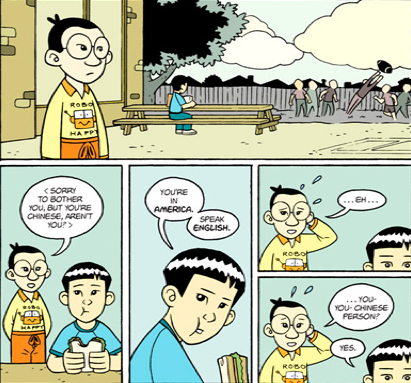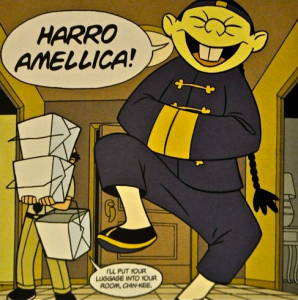When we were asked to choose a book it was so hard to pick one because they all looked so interesting. I ended up choosing “American Born Chinese” by Gene Luen Yang because the pictures when I flipped through the book interested me a lot. specifically this one:
I thought, this must be about racial issues in America… (because there is no way it would depict a Chinese person in this way without some indication that racism is wrong) So, I really wanted to see how the author would wrap up the novel.
There are 3 stories within the book, which alternate and connect as you move throughout the book; they target different reactions to racism.
The first is about the very proud and self righteous monkey king who experiences racism (or a form a prejudice where he is seen as lesser for being a monkey). The monkey king handles it by lashing out and taking drastic measures to hurt the people who hurt him. This one interested me because it drew on how Chinese culture often uses myth and parables to tell stories. He also goes on to study the highest levels of Kung-Fu, which gives an even stronger tie to Chinese traditional culture.
The second story is about a Chinese boy, Jin Wang, in an American class – this is the story we can all relate to the best. It shows the type of racism that probably happens all the time in our high schools. The Chinese-American boy is singled out and not accepted by the white students (even though he was born in America and speaks English fluently) He ends up suffering silently, not having friends and wishing he were white. He lacks confidence and can’t see what others value in him.
The third story is about a white boy, Danny, who has a Chinese cousin “Chin-Kee”, Chin-kee is the ultimate stereotype of a Chinese person or “F.O.B.”. In this story, Danny is extremely embarrassed of Chin-Kee and his Chinese way of acting; he believes that he will lose all of his friends and the respect of the whole school and he will eventually be teased so much that he will need to switch schools. This Chinese stereotype was displayed in Chin-Kee’s language: R and L (shown in the above picture), the food he ate: which had a cats head in it, the jokes he made: which were just weird, his name: Chin-Kee, and the way he appeared: buck-teeth, school uniform, slanted eyes, etc.
All of these stories do, in fact, tie together in the end and make a very nice conclusion that promotes acceptance. It would be an excellent way to bring an alternate form of literature into a classroom and discuss the effects of racism with students.
-Katie
Ps. Sorry for posting late, I was having major internet problems.



3 responses so far ↓
kiranheer // Sep 25th 2012 at 2:10 pm
I was attracted to this blog post for the same reason you listed above – the picture of the racial stereotype of the Chinese boy. I’m intrigued and hope I can get a copy of the graphic novel because I’m curious to see how the author ties the three stories together at the end.
Also, I agree completely, I think this would be a great novel to use in a class when talking about racism and acceptance.
kairosman // Sep 25th 2012 at 9:36 pm
The visual styles on offer are interesting and I agree that the caricatures are deliberately referencing stereotypes. I was intrigued by the monkey king story line in which the protagonist lashes out at his tormentors… when he goes on to master Kung-Fu, is he shown to be more enlightened? Very curious about this and the visual style employed compared to the styles on offer in your blog post – will make sure to check it out when I get to class tomorrow. As an aside, I find the lack of clearly defined gender in many manga styles such as this one to be fascinating, and often connect the ambiguities of the sexual politics of the manga generation to my inability to read the reasons for it – is it just me or is there something really odd going on here?
Anyway, you mention that the caricatures promote acceptance and sympathy via a shared cross-cultural comic/manga/anime universe of shared symbols and tropes and memes (or is that just my reading of what you are getting at?), yet young people continue to construct each other as Other. If the Internet via its digital, “virtual” cultures create opportunities via manga anime gaming etc. for meaningful cross-cultural dialog, how do we account for the ongoing struggle to inculcate acceptance?
What if some from another culture value the racial/cultural differences, and consciously exclude/denigrate the Other based on class (for example), like the reverse stereotypes the wealthy Chinese kids construct of other kids, whether Chinese or Korean or Japanese or White or Black or Latino etc.? Having spent a lot of time tutoring the scions of the Chinese nouveau riche, I can tell you that many are powerfully engaged in constructing their own universe of privilege.
“Of course the necessary negotiation of differences will be difficult and often painful. The dialogue will encounter chasms of difference in values, grossly unjust inequalities, and difficult but necessary border crossings. The differences are not as neutral, colorful, and benign as multiculturalism might want us to believe. Yet as workers, citizens, and community members, we will all need the skills required to negotiate these differences” (The New London Group).
But despite the acknowledgement here that these differences are not “benign” (from our point of view), the underlying assumption, that we should expect other cultures to “negotiate” with us and our values, is profoundly problematic: I have many students who tell me quite plainly that they have no interest in such things as “diversity” or “multiculturalism” and “acceptance” etc.
As their parents are worth a hundred million dollars or more, these values appear superfluous to them.
And who am I to teach them otherwise? If I believe in acceptance, then do I not also have to defend my students’ right to those values?
Works Cited
Cazden, C., Cope, B., Fairclough, N., & Gee, J. (1996). A pedagogy of multiliteracies: Designing social futures. Harvard Educational Review, 66(1), 60-92.
TMD // Sep 26th 2012 at 9:51 am
Those of you who enjoyed this book may be interested in Gene Luen Yang’s lecture on graphic novels here: http://vimeo.com/13488361
With students it is interesting to consider the popular culture references in _American Born Chinese_, as well as the visual references that suggest the text is in fact a stage or screen. (Did you notice, for example, the “laugh track”?)
Teresa
You must log in to post a comment.